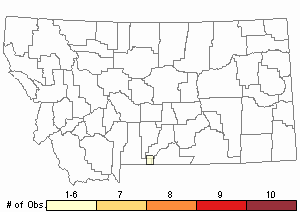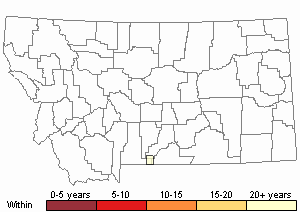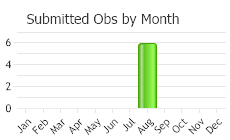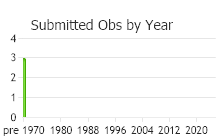View in other NatureServe Network Field Guides
NatureServe
Montana
Utah
Wyoming
Idaho
Wisconsin
British Columbia
South Carolina
Yukon
California
New York
Waterfall Copper Moss - Haplodontium macrocarpum
Other Names:
Mielichhoferia macrocarpa, Bryum porsildii
State Rank Reason (see State Rank above)
One specimen collected from a population growing on a wet limestone cliff in Park County, MT in 1973.
General Description
Plant: Forming cushions or compact tufts, light green to pinkish green above, brown to reddish-brown below. Stems modestly to robustly branching with subfloral innovations , 0.5-3 cm high.
Leaves: Flexuose or turning to one side when dry, erect but not appressed when moist; ovate to oblong or broadly lanceolate, 0.6 – 2 mm in length. Margins slightly rolled back proximally, 1-stratose, lacking a limbidium. Apex broadly acute or occasionally acuminate, seldom with a laminal tip. Costa light brown or red, percurrent or subpercurrent, seldom extending beyond the leaf in a hair-like tip.
Leaf Cells: Alar cells short- to long-rectangular, irregularly so and not clearly differentiated. Proximal laminal cells and medial cells rhomboidal to elongate-rhomboidal, 4 – 6:1. Distal cells elongate. Medial and distal cell walls thin.
Seta/Capsule: Seta 0.4 – 1.2 cm, yellow-brown, flexuose. Capsule upright to drooping, 1.3 – 2.5 mm, maturing in summer (July – August).
(FNA 2014; Flowers 1973)
Range Comments
North American endemic. Occurs across Arctic America from the Aleutian Islands to western Greenland, southward in the Rocky Mountains to Colorado and Utah (Flowers 1973). Also in Newfoundland (Hedderson et al 1982). World distribution mapped by Brassard (1971); not much changed since that map was published, except the addition of Alaska, Newfoundland (1 stn), and Alberta (1 stn) populations. In Montana: Park County (Elliott 2016).
Observations in Montana Natural Heritage Program Database
Number of Observations: 6
(Click on the following maps and charts to see full sized version)
Map Help and Descriptions
Relative Density

Recency


 (Observations spanning multiple months or years are excluded from time charts)
(Observations spanning multiple months or years are excluded from time charts)
Habitat
Moist to seepy rock faces and crevices, arctic-alpine, in a wide range of elevations (1 – 11,500 feet). Apparently limited to limestone in the southern and central Rocky Mountains, but can grow on other kinds of mineral-rich rock (FNA 2014).
Reproductive Characteristics
Dioicous (FNA 2014).
Stewardship Responsibility
References
- Literature Cited AboveLegend:
 View Online Publication
View Online Publication Brassard, G.R. 1971. The mosses of Northern Ellesmere Island, Arctic Canada. II. Annotated list of the taxa. Bryologist 74: 282-311.
Brassard, G.R. 1971. The mosses of Northern Ellesmere Island, Arctic Canada. II. Annotated list of the taxa. Bryologist 74: 282-311. Crum, H.A. and L.E. Anderson. 1981. Mosses of Eastern North America. 2 volumes. Columbia University Press, New York. 1328 pp.
Crum, H.A. and L.E. Anderson. 1981. Mosses of Eastern North America. 2 volumes. Columbia University Press, New York. 1328 pp. Elliott, J.C. and A.K. Pipp. 2018. A Checklist of Montana Mosses (1880-2018). Updated 3 January, 2020. Montana Natural Heritage Program, Helena, Montana. 73 pp.
Elliott, J.C. and A.K. Pipp. 2018. A Checklist of Montana Mosses (1880-2018). Updated 3 January, 2020. Montana Natural Heritage Program, Helena, Montana. 73 pp. Flora of North America Editorial Committee, eds. 2014. Flora of North America North of Mexico. Volume 28. Bryophytes: Mosses, Part 2. Oxford University Press, Inc., NY. xxi + 702 pp.
Flora of North America Editorial Committee, eds. 2014. Flora of North America North of Mexico. Volume 28. Bryophytes: Mosses, Part 2. Oxford University Press, Inc., NY. xxi + 702 pp. Flowers, S. 1973. Mosses: Utah and the West. Brigham Young University, Provo, Utah. 567 p.
Flowers, S. 1973. Mosses: Utah and the West. Brigham Young University, Provo, Utah. 567 p. Hedderson, T., G.R. Brassard, and R.J. Belland. 1982. New or additional moss records from Newfoundland VII. Bryologist 85: 442-443.
Hedderson, T., G.R. Brassard, and R.J. Belland. 1982. New or additional moss records from Newfoundland VII. Bryologist 85: 442-443.
- Additional ReferencesLegend:
 View Online Publication
View Online Publication
Do you know of a citation we're missing? Elliot, J. C. 1993. Second checklist of Montana mosses. Unpublished report. U.S. Forest Service, Region 1. Missoula, MT. 45 pp.
Elliot, J. C. 1993. Second checklist of Montana mosses. Unpublished report. U.S. Forest Service, Region 1. Missoula, MT. 45 pp. Lawton, E. 1971. Keys for the Identification of the Mosses on the Pacific Northwest. Reprinted from 'Moss Flora of the Pacific Northwest'. Published as Supplement No. 2 of the Journal of the Hattori Botanical Laboratory. Nichinan, Miyazaki, Japan. 66 pp.
Lawton, E. 1971. Keys for the Identification of the Mosses on the Pacific Northwest. Reprinted from 'Moss Flora of the Pacific Northwest'. Published as Supplement No. 2 of the Journal of the Hattori Botanical Laboratory. Nichinan, Miyazaki, Japan. 66 pp. Lawton, E. 1971. Moss Flora of the Pacific Northwest. Hattori Botanical Laboratory. Japan: Yamabuki-cho, Shinjuku-ku, Tokyo. 362 pages plus appendices.
Lawton, E. 1971. Moss Flora of the Pacific Northwest. Hattori Botanical Laboratory. Japan: Yamabuki-cho, Shinjuku-ku, Tokyo. 362 pages plus appendices.
- Web Search Engines for Articles on "Waterfall Copper Moss"





